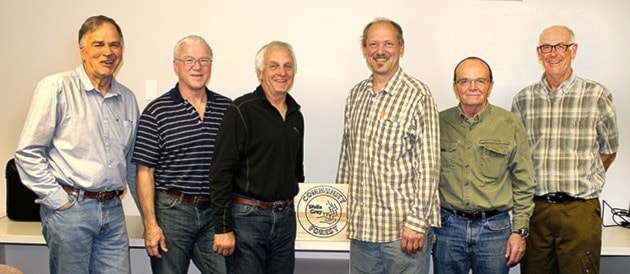During its first three or four years of operation, Wells Gray Community Forest logged mostly dead pine that had been killed by mountain pine beetle, according to Dave Meehan, corporation president.
At the same time, timber prices were depressed because of the 2008 recession.
Despite the difficulties, the community forest survived and was even able to begin giving out grants to deserving community projects.
Over the last two years WGCF has been harvesting less dead pine and more green wood. At the same time, the timber markets have been improving.
The community forest made a gross profit of $750,000 during the fiscal year ending Oct. 31, 2014, Meehan reported.
Of this, $250,000 was transferred to Wells Gray 2010 Society to be distributed to the community.
 The remainder is being kept in reserves for such things as silviculture.
The remainder is being kept in reserves for such things as silviculture.
The local community forest has a three-part structure.
Wells Gray Community Forest Corporation is the operational arm. It generates income by selling logs through a competitive bid process to local logging contractors.
The successful bidders were Dale Miller Logging and Wadlegger Logging and Construction.
The contractors in turn sell the logs to sawmills – mostly Canfor and Interfor, but also Gilbert Smith, Tolko, Wadlegger Specialty Forest Products and Colborne Lumber.
Wells Gray 2010 Society is responsible for distributing a portion of the community forest's profits to eligible proponents in Wells Gray Country and Clearwater. The funds are distributed twice a year.
Community Forest Advisory Committee promotes the community forest to the public and brings public input to the corporation's board.
The community forest has three operating areas: Raft, East Blackpool and Burnell.
The latter operating area is named after the late Leverne Burnell, who played a lead role in getting the community forest established.
A total of 42,000 cubic meters of wood were harvested during the fiscal year.
This was 11,000 cubic meters above the community forrest's annual allowable cut, taking advantage of higher prices and demand.
Most of the logging took place in the Raft operating area northeast of Clearwater. A total of 22,000 cubic meters were taken, a mix of subalpine fir and spruce.
The community forest's second operating area, East Blackpool, contributed 1,500 cubic meters of Douglas fir and lodgepole pine.
About 19,000 cubic meters were taken from the Burnell operating area west of town. The logs were a mix of Douglas fir and lodgepole pine.
During the fiscal year 4.6 km of permanent road plus an 18 m bridge were installed on the Burnell road.
In 2013 the community forest completed a forest stewardship plan – a higher level plan that outlines the strategies that will be used to achieve measurable results.
In 2104 the community forest planted 169 ha with 230,000 seedlings. Species were roughly one-third Douglas fir, one-third Engelmann Spruce, one-third lodgepole pine, plus some western red cedar.
Some plantations were fertilized to increase growth.
A total of 18 ha was brushed to reduce the impacts of competing species.
